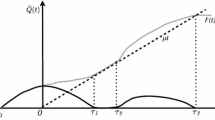Abstract
The diffusion approximation is proved for a class of queueing networks, known as re-entrant lines, under a first-buffer-first-served (FBFS) service discipline. The diffusion limit for the workload process is a semi-martingale reflecting Brownian motion on a nonnegative orthant. This approximation has recently been used by Dai, Yeh and Zhou [21] in estimating the performance measures of the re-entrant lines with a FBFS discipline.
Similar content being viewed by others
References
A. Berman and R.J. Plemmons,Nonnegative Matrices in the Mathematical Sciences (Academic Press, New York, 1979).
P. Billingsley,Convergence of Probability Measures (Wiley, New York, 1968).
H. Chen, Fluid approximations and stability of multiclass queueing networks: work-conserving disciplines,Annals of Applied Probability 5 (1995) 637–655.
H. Chen and A. Mandelbaum, Stochastic discrete flow networks: diffusion approximations and bottlenecks,Annals of Probability 19 (1991) 1463–1519.
H. Chen and A. Mandelbaum, Hierarchical modelling of stochastic networks, Part II: Strong approximations, in:Stochastic Modeling and Analysis of Manufacturing Systems, ed. D.D. Yao (Springer-Verlag, 1994) pp. 107–131.
H. Chen and H. Zhang, Diffusion approximations for multiclass FIFO queueing networks,Annals of Applied Probability (submitted).
J. Dai and W.Y. Dai, Diffusion approximations for queueing networks with finite capacity, preprint (1995).
J. Dai and T.G. Kurtz, A multiclass station with Markovian feedback in heavy traffic,Mathematics of Operations Research 20 (1995) 721–742.
J. Dai and V. Nguyen, On the convergence of multiclass queueing networks in heavy traffic,Annals of Applied Probability 4 (1994) 26–42.
J. Dai and Y. Wang, Nonexistence of Brownian models of certain multiclass queueing networks,Queueing Systems 13 (1993) 41–46.
J. Dai and G. Weiss, Stability and instability of fluid models for certain re-entrant lines,Mathematics of Operations Research 21 (1996) 115–134.
J. Dai, D.H. Yeh and C. Zhou, The QNET method for re-entrant queueing networks with priority disciplines,Operations Research (to appear).
P.W. Glynn, Diffusion approximations, in:Handbooks in Operations Research and Management Science, II: Stochastic Models, eds. D.P. Heyman and M.J. Sobel (North-Holland, Amsterdam, 1990).
J.M. Harrison,Brownian Motion and Stochastic Flow Systems (Wiley, New York, 1985).
J.M. Harrison and V. Nguyen, Brownian models of multiclass queueing networks: current status and open problems,Queueing Systems 13 (1993) 5–40.
J.M. Harrison and M.I. Reiman, Reflected Brownian motion on an orthant,Annals of Probability 9 (1981) 302–308.
J.M. Harrison and R.J. Williams, A multiclass closed queueing network with unconventional heavy traffic behavior,Annals of Applied Probability 6 (1996) 1–47.
D.P. Johnson, Diffusion approximations for optimal filtering of jump processes and for queueing networks, PhD Thesis, University of Wisconsin (1983).
P.R. Kumar, Re-entrant lines,Queueing Systems 13 (1993) 87–110.
A. Mandelbaum and W.A. Massey, Strong approximations for time-dependent queues,Mathematics of Operations Research 20 (1995) 33–64.
G. Pats, State-dependent queueing networks: Approximations and applications, PhD Thesis, Technion, Israel (1995).
W.P. Peterson, A heavy traffic limit theorem for networks of queues with multiple customer types,Mathematics of Operations Research 16 (1991) 90–118.
A. Puhalskii, On the invariance principle for the first passage time,Mathematics of Operations Research 19 (1994) 946–954.
M.I. Reiman, Open queueing networks in heavy traffic,Mathematics of Operations Research 9 (1984) 441–458.
M.I. Reiman, A multiclass feedback queue in heavy traffic,Advances in Applied Probability 20 (1988) 179–207.
H.L. Royden,Real Analysis (Macmillan, New York, 1988).
A.V. Skorohod, Limit theorems for stochastic processes,Theory of Probability and Its Applications 1 (1956) 261–290.
L.M. Taylor and R.J. Williams, Existence and uniqueness of semimartingale reflecting Brownian motions in an orthant,Probability Theory and Related Fields 96 (1993) 283–317.
W. Whitt, Some useful functions for functional limit theorems,Mathematics of Operations Research 5 (1980) 67–85.
K. Yamada, Diffusion approximations for open state-dependent queueing networks under heavy traffic situation, Technical Report, Institute of Information Science and Electronics, University of Tsukuba, Japan (1993)
P. Yang, Least controls for a class of constrained linear stochastic systems,Mathematics of Operations Research 18 (1993) 275–291.
Author information
Authors and Affiliations
Additional information
Supported in part by a grant from NSERC (Canada).
Supported in part by a grant from NSERC (Canada); the research was done while the author was visiting the Faculty of Commerce and Business Administration, UBC, Canada.
Rights and permissions
About this article
Cite this article
Chen, H., Zhang, H. Diffusion approximations for re-entrant lines with a first-buffer-first-served priority discipline. Queueing Syst 23, 177–195 (1996). https://doi.org/10.1007/BF01206556
Received:
Revised:
Issue Date:
DOI: https://doi.org/10.1007/BF01206556




